Editor’s Introduction
Many birds, wild, stray and pet, are killed by cats and dogs. (Stray domestic pigeons and doves are at terrible risk from pets and predators and must be brought into safety!) There is a very real risk involved with what Palomacy calls “blended families”, homes which include birds, cats and/or dogs. We work with each family on a case by case basis to help them introduce birds to their pets and teach them how to insure their safety. (Please read How to Choose a Cage.) The birds adjust quickly and aren’t much concerned and the majority of dogs and cats settle down and accept the new family members with impressive equanimity. We have found, with 10 years of experience and more than 800 birds served, that the risk can be managed so that it is very low on the list of threats to our pet birds, provided people take responsibility for protecting the birds. With care, we have been incredibly successful in keeping our foster and adopted birds safe alongside the dogs and cats they share homes with. (We have found that the health of our birds is much more likely to be threatened by getting out/lost, injuries from other birds, cancer, reproductive disease or worms than by supervised dogs and cats.) Here are recommendations from one of Palomacy’s most expert volunteers, Jill McMurchy.
Guest Post by Jill McMurchy
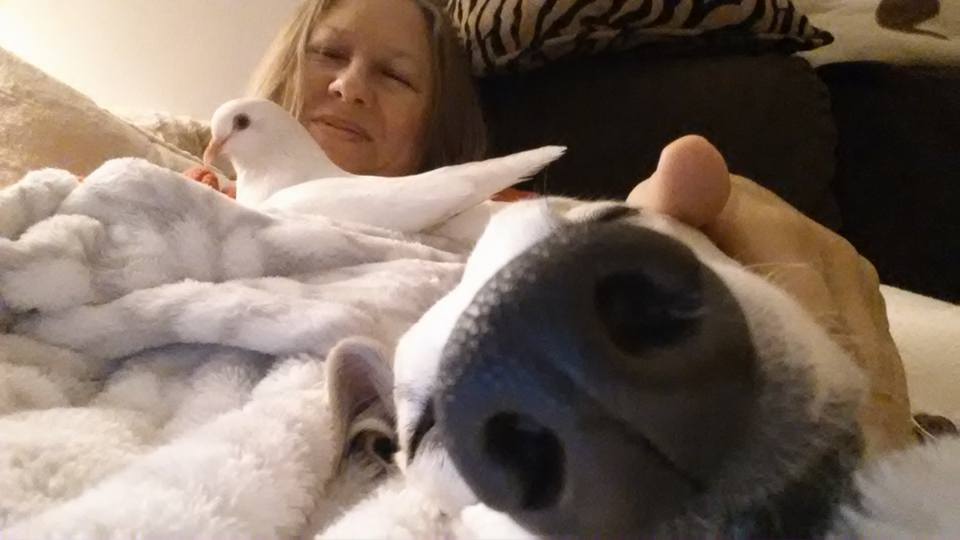
Jill, Tango & Jasper having a snuggle
Often, while introducing pigeons to the public, I hear people say “I can’t have birds, I have cats (or dogs)” to which I reply, “So do I!”. They usually look surprised and ask how is that possible? It takes patience, care and common sense.
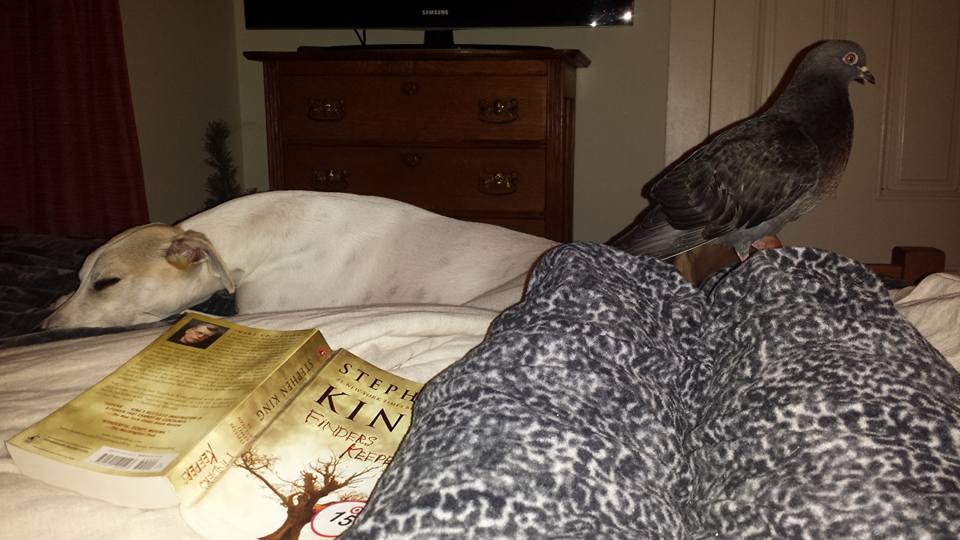
Jasper & Pudge
I’ve had dogs (at least three) and cats since I rescued my first pigeon in 2011. Not knowing I would be keeping Elinor, I introduced my dogs and cats to him slowly. Elinor was recovering from partial wing amputation when I brought him home so it was important to keep him in the house. My dogs had never been around a bird before, other than seeing them outside on our walks. I’d like to note as well that I have sight hounds, known for their deep instinct to hunt based on sight, not smell. Elinor was sequestered in a room, by himself, to quietly heal. In the few weeks he spent in the house, my dogs could smell and see him from time to time when I brought them in the room, one by one, always with Elinor safe in his cage. These were very short visits and I always praised them for ignoring him and focusing on me.
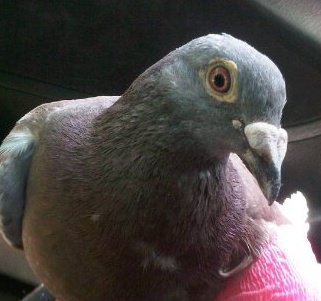
Pigeon-racing survivor Elinor recovering
It didn’t take long for my dogs to figure out Elinor was a part of the pack and, in my dogs’ eyes, quite boring. He didn’t flit around, but rather stayed in one spot and preened, looked out the window and well, didn’t do much. This is typical pigeon behavior. They are masters of the leisure arts, spending much of the day napping, preening and eating. After a couple of weeks, they saw him as a fixture in this house.
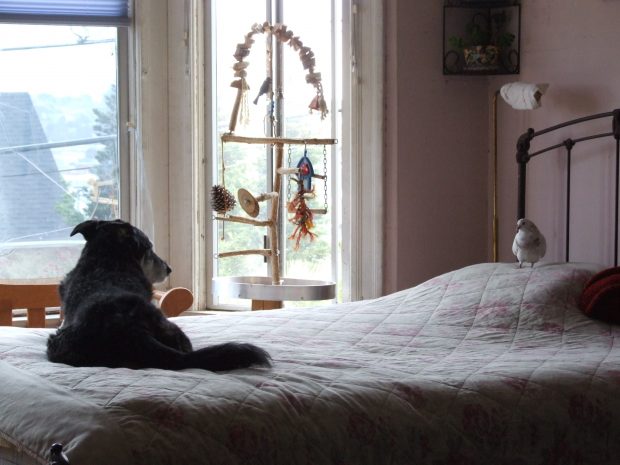
Elizabeth’s dog Monkey & foster pigeon Betti hanging out
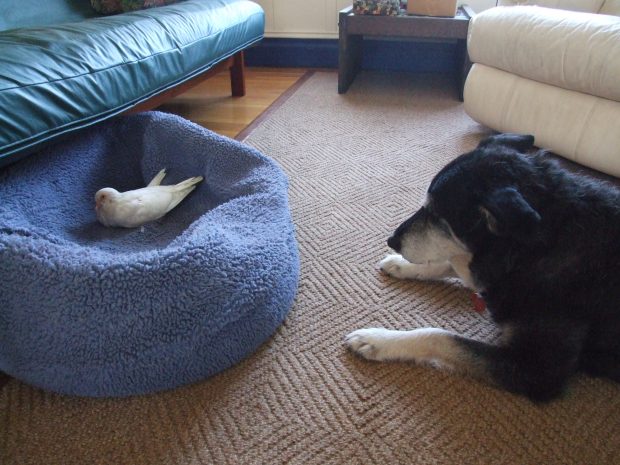
Healing King pigeon youngster Gypsy makes herself at home in Monkey’s bed
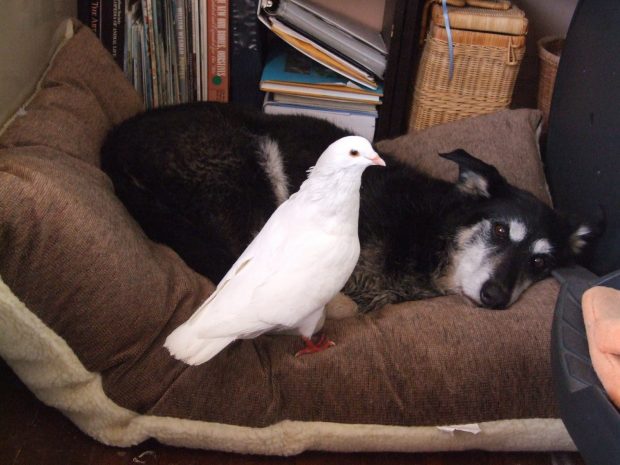
Elizaebth’s dog Monkey, shown here with her King pigeon Frances, was a very tolerant, gentle dog (and always supervised).
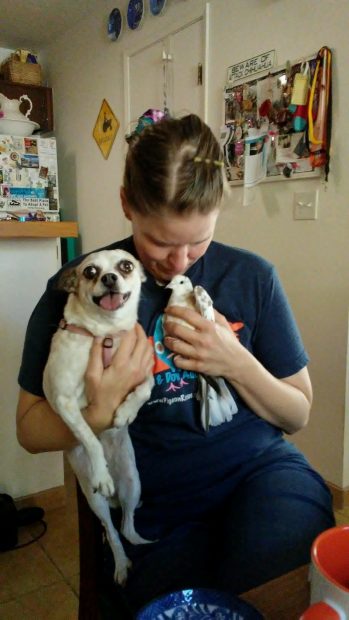
Not all dogs are chill with pet birds. Liese, shown here with foster dove Legion, supervises her dog Lily carefully.
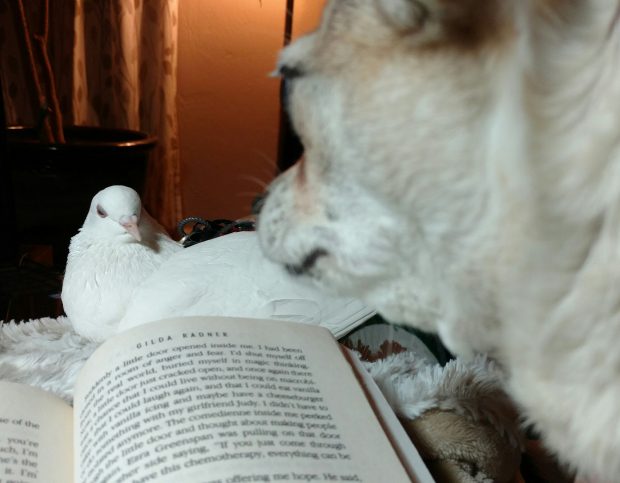
Pet pigeon Peanut & chihuahua Lily sharing their beloved Liese
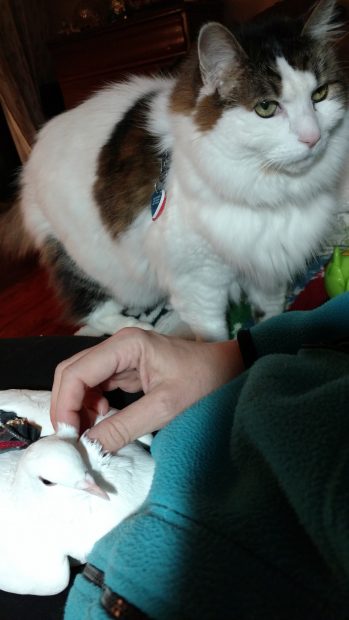
Fizzy patiently waiting his turn…
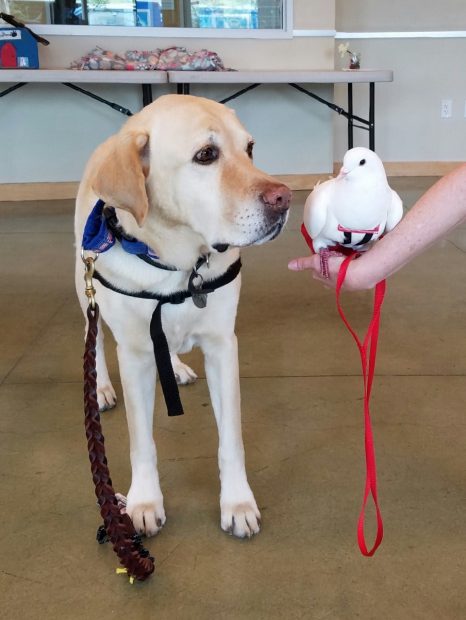
Wyatt, a Love on a Leash dog, meeting foster pigeon José at an HSSV birthday party
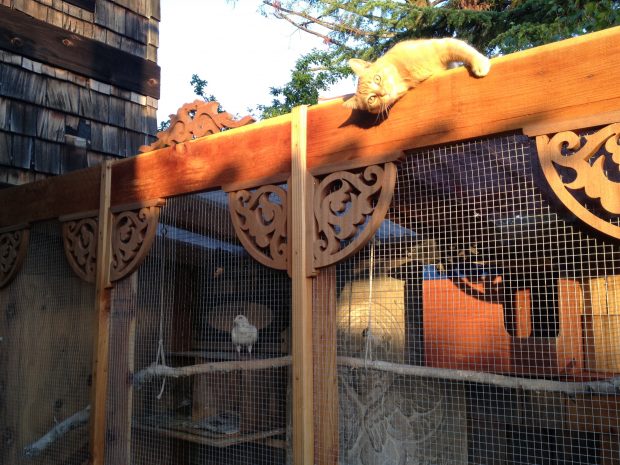
Cats love aviaries and the birds safe inside, like Laurie’s Polka Dot shown here, find the cats more amusing than worrisome.
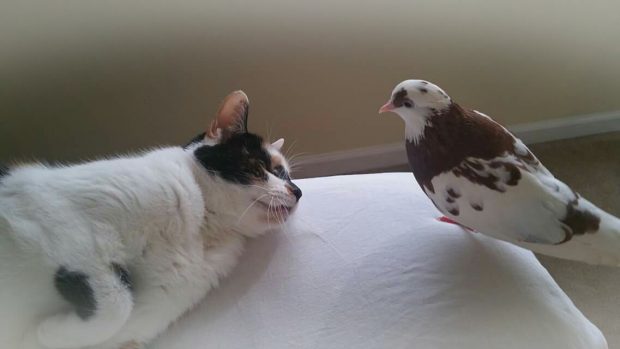
Marjory’s cat Annie & rescued pet pigeon Timothea have a chat
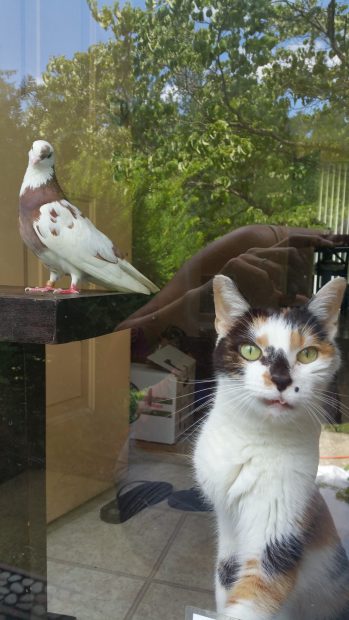
With care & supervision, birds and cats can live safely together
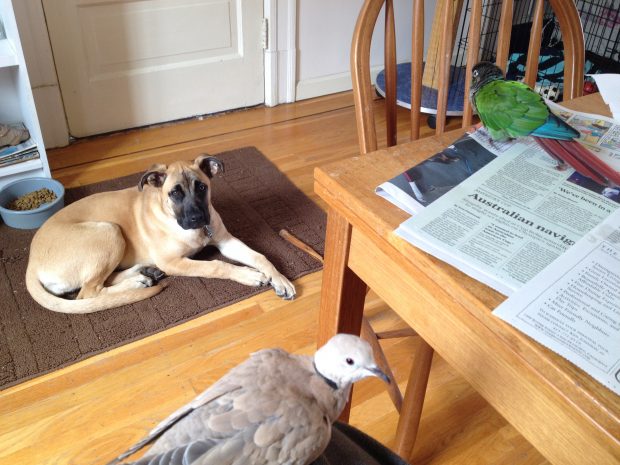
Pup Ruby learning about life with birds, dove Lily & parrot Tookie. (Birds can hurt one another & need to be managed carefully as well.)
In my experience, it’s important to let the other pets see the bird, smelling and getting a feel for bird behavior, the wing flapping, and the sounds ALWAYS IN A SUPERVISED AND CALM SETTING and always for short amounts of time, lengthening the exposure as time went on. I would often walk into the room with one dog at a time and focus my time and energy on something other than Elinor, then walk out – always giving the dog a treat for being calm and listening to me. If there was any excitement, we’d exit the room, no treat and enter again. Calm behavior was what I was looking for. If this sounds labor intensive, it really isn’t. It’s 5 minutes here, 10 minutes there. In the long run, it’s worth it.
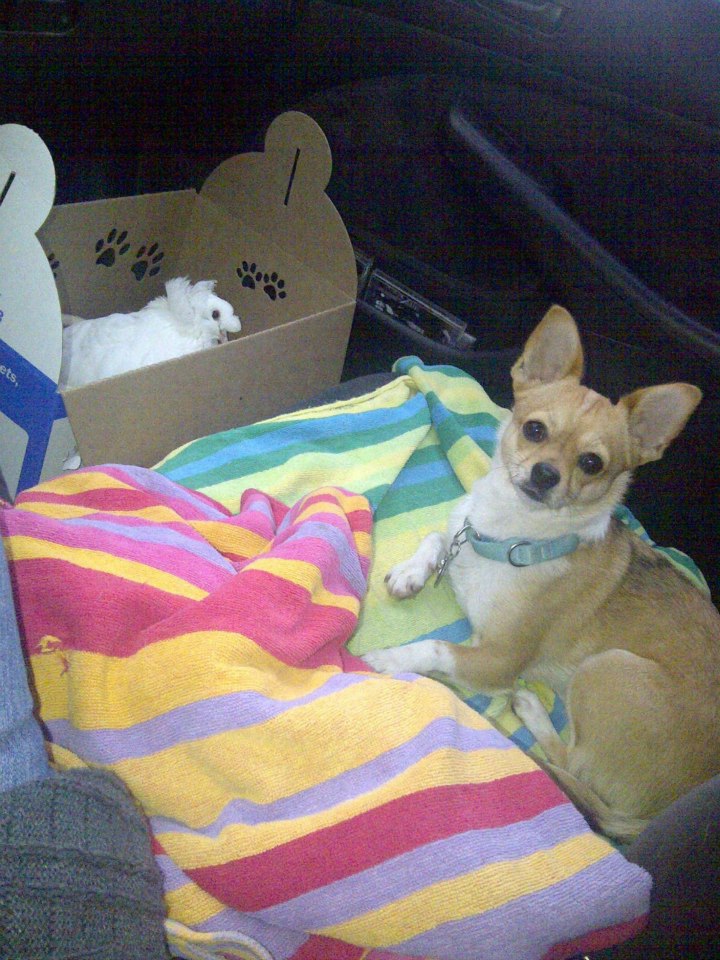
Jill’s Chanel & Shelby sharing the shotgun seat
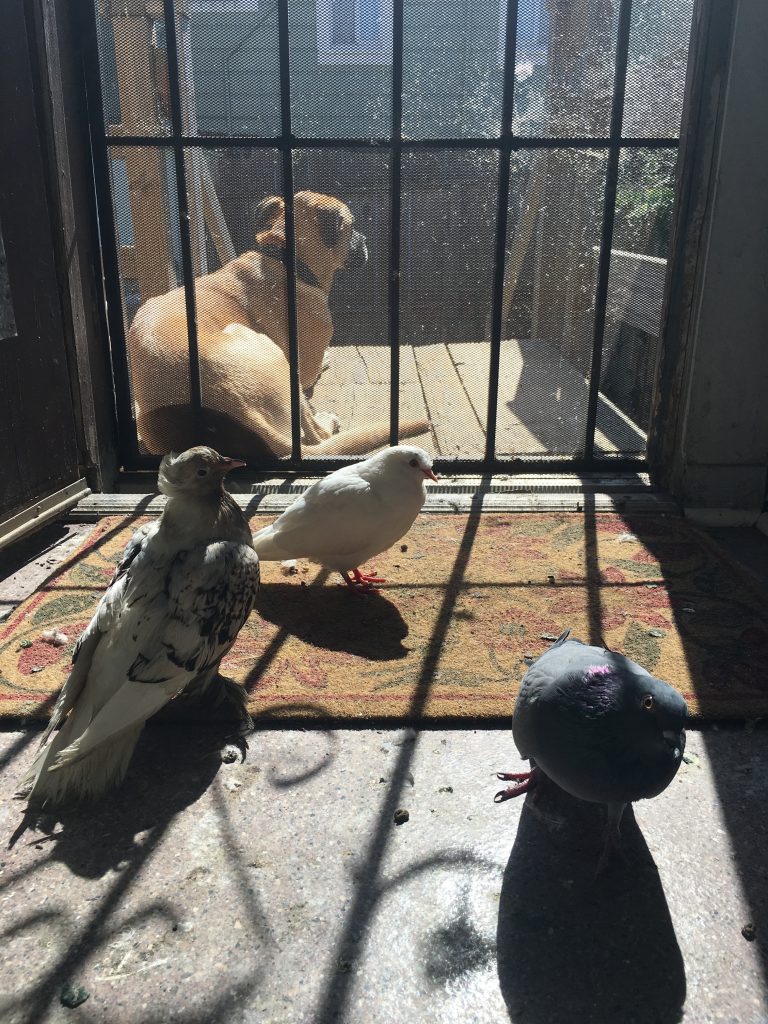
Foster pigeons JJ, Bug & Charlie hanging out in the sun with Elizabeth’s dog Ruby
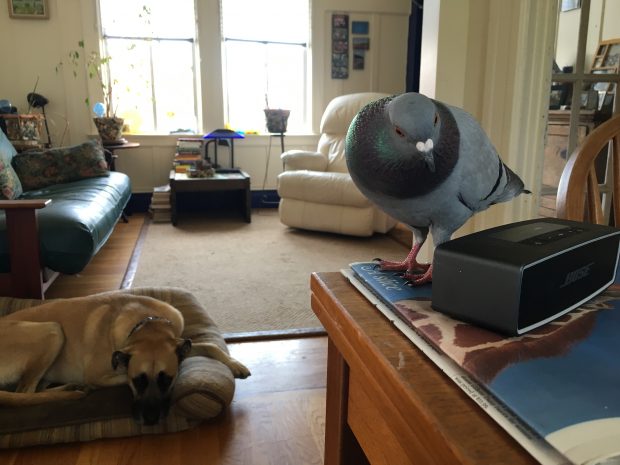
Ruby was taught that birds are off limits but she is still never unsupervised with out-of-cage birds
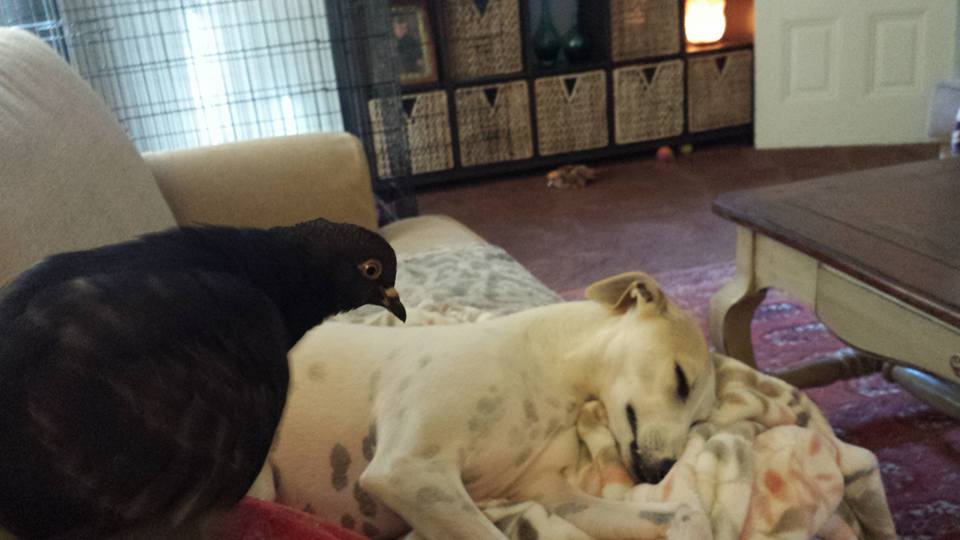
Nosy pigeon Pudge creeping on Jill’s Jasper
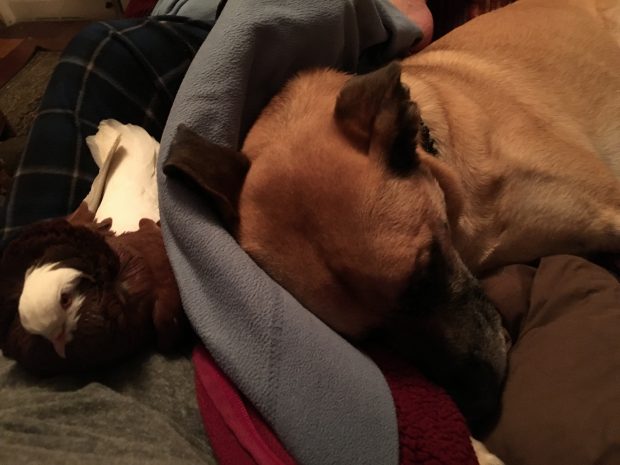
Quiet times are especially good for hanging out together as Elizabeth, Jacob and Ruby are here.
Here are some guidelines and ideas that I think are important –
- It’s ALWAYS important to make the bird feel secure. A stressed-out pigeon isn’t a happy pigeon. Once pigeons know they are safe, their confidence level goes up. They know that their cage equals safety. I never let the dogs invade their space. This includes when a pigeon is out and they’ve claimed an area (usually high up) that they feel is theirs. If it’s their cage, the dog isn’t allowed to stick their head in the cage or invade that space.
- Supervision. Always. If I have a bird loose in the house, I don’t leave the room without the bird. Ever. I will never trust my dogs or cats 100% if left to their own devices. Instinct is instinct.
- Common sense. If the bird remains in a closed room and is never exposed to your other pets, it’s natural that their curiosity will make them crazy. To know a pigeon is to love a pigeon, even for dogs.
- Wherever your birds are housed, their enclosure needs to protect them from the animals that have access to it. If you have cats, an indoor bird’s cage needs to have narrow bar-spacing to keep paws out. Even a small nick by a cat claw can result in death to a bird. Cats and dogs carry deadly bacteria in their mouths and claws called pasturella. I’ve had the unfortunate experience of seeing a pigeon suffer a slow and excruciatingly painful death when I wasn’t told a cat caught a pigeon I had picked up at a good Samaritan’s house. Even as someone who knows how to look over a pigeon for puncture wounds, I missed one and by the time I got her to the vet she had to be euthanized. Feathers hide a lot.
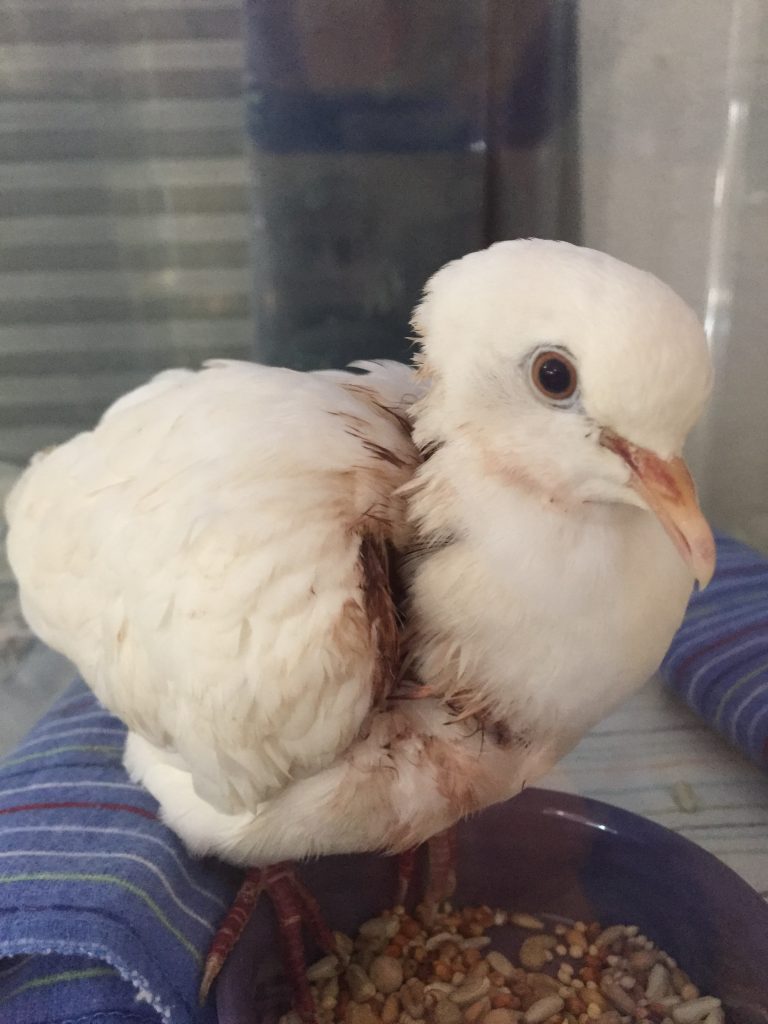
Dove Carl, housed in an unsafe cage, was nearly killed by one little kitten paw reaching in. (Palomacy rescued him.)

Jill & Georgie (Photo by Elisabeth Millay)
Jill is the partner to a scientist/farmer, mother of three plus two bonus kids, caregiver and animal lover. She has rescued dogs, cats, chickens, amazing pigeons and a deer mouse named Bizzee. She’s living the dream on an acre of land in Sunol and feels absolutely blessed to have found Elinor the racing pigeon on the side of the road in 2011. He came HOME with me that day and life has never been the same.
